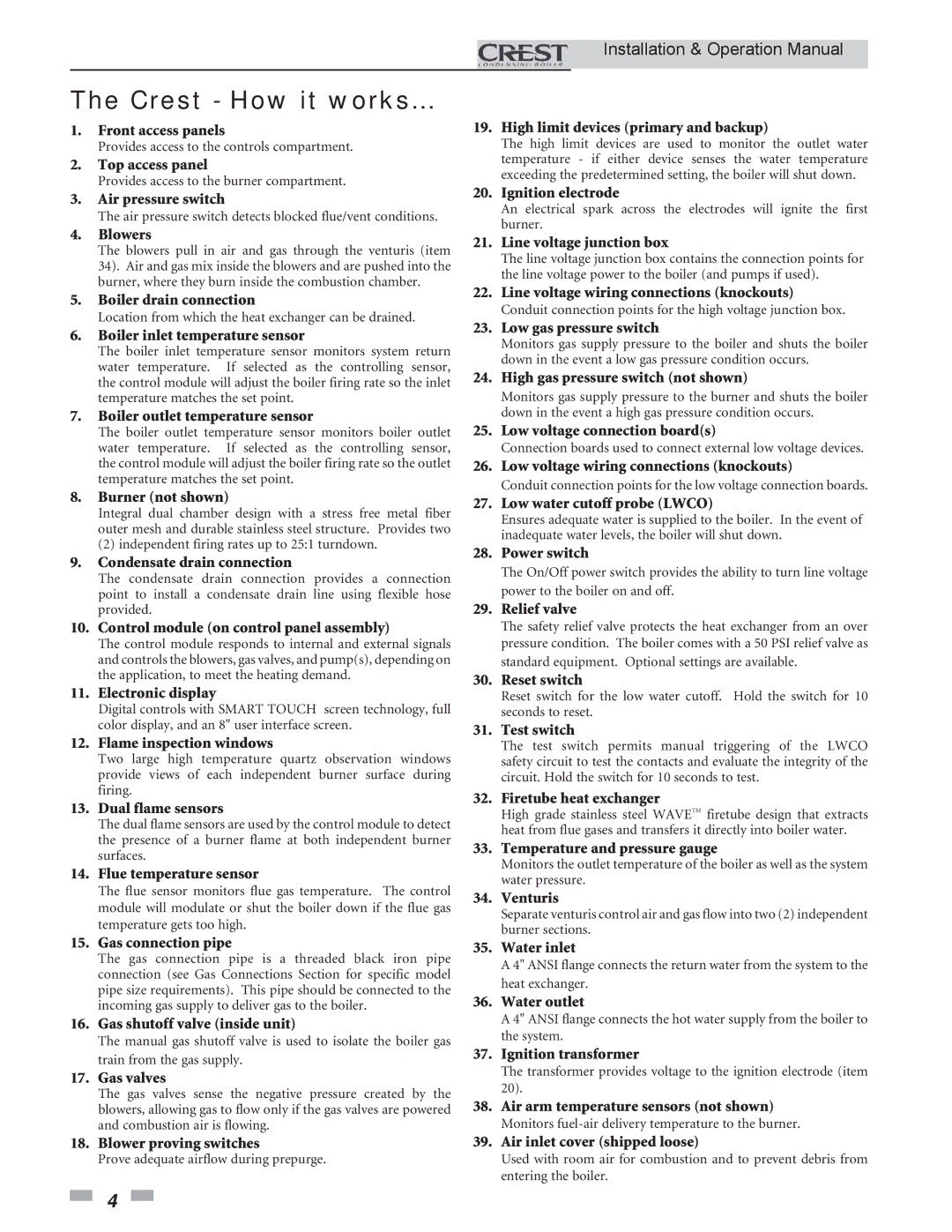
The Crest - How it works...
1.Front access panels
Provides access to the controls compartment.
2.Top access panel
Provides access to the burner compartment.
3.Air pressure switch
The air pressure switch detects blocked flue/vent conditions.
4.Blowers
The blowers pull in air and gas through the venturis (item 34). Air and gas mix inside the blowers and are pushed into the burner, where they burn inside the combustion chamber.
5.Boiler drain connection
Location from which the heat exchanger can be drained.
6.Boiler inlet temperature sensor
The boiler inlet temperature sensor monitors system return water temperature. If selected as the controlling sensor, the control module will adjust the boiler firing rate so the inlet temperature matches the set point.
7.Boiler outlet temperature sensor
The boiler outlet temperature sensor monitors boiler outlet water temperature. If selected as the controlling sensor, the control module will adjust the boiler firing rate so the outlet temperature matches the set point.
8.Burner (not shown)
Integral dual chamber design with a stress free metal fiber outer mesh and durable stainless steel structure. Provides two
(2) independent firing rates up to 25:1 turndown.
9.Condensate drain connection
The condensate drain connection provides a connection point to install a condensate drain line using flexible hose provided.
10.Control module (on control panel assembly)
The control module responds to internal and external signals and controls the blowers, gas valves, and pump(s), depending on the application, to meet the heating demand.
11.Electronic display
Digital controls with SMART TOUCH screen technology, full color display, and an 8" user interface screen.
12.Flame inspection windows
Two large high temperature quartz observation windows provide views of each independent burner surface during firing.
13.Dual flame sensors
The dual flame sensors are used by the control module to detect the presence of a burner flame at both independent burner surfaces.
14.Flue temperature sensor
The flue sensor monitors flue gas temperature. The control module will modulate or shut the boiler down if the flue gas temperature gets too high.
15.Gas connection pipe
The gas connection pipe is a threaded black iron pipe connection (see Gas Connections Section for specific model pipe size requirements). This pipe should be connected to the incoming gas supply to deliver gas to the boiler.
16.Gas shutoff valve (inside unit)
The manual gas shutoff valve is used to isolate the boiler gas train from the gas supply.
17.Gas valves
The gas valves sense the negative pressure created by the blowers, allowing gas to flow only if the gas valves are powered and combustion air is flowing.
18.Blower proving switches
Prove adequate airflow during prepurge.
Installation & Operation Manual
19.High limit devices (primary and backup)
The high limit devices are used to monitor the outlet water temperature - if either device senses the water temperature exceeding the predetermined setting, the boiler will shut down.
20.Ignition electrode
An electrical spark across the electrodes will ignite the first burner.
21.Line voltage junction box
The line voltage junction box contains the connection points for the line voltage power to the boiler (and pumps if used).
22.Line voltage wiring connections (knockouts)
Conduit connection points for the high voltage junction box.
23.Low gas pressure switch
Monitors gas supply pressure to the boiler and shuts the boiler down in the event a low gas pressure condition occurs.
24.High gas pressure switch (not shown)
Monitors gas supply pressure to the burner and shuts the boiler down in the event a high gas pressure condition occurs.
25.Low voltage connection board(s)
Connection boards used to connect external low voltage devices.
26.Low voltage wiring connections (knockouts)
Conduit connection points for the low voltage connection boards.
27.Low water cutoff probe (LWCO)
Ensures adequate water is supplied to the boiler. In the event of inadequate water levels, the boiler will shut down.
28.Power switch
The On/Off power switch provides the ability to turn line voltage power to the boiler on and off.
29.Relief valve
The safety relief valve protects the heat exchanger from an over pressure condition. The boiler comes with a 50 PSI relief valve as standard equipment. Optional settings are available.
30.Reset switch
Reset switch for the low water cutoff. Hold the switch for 10 seconds to reset.
31.Test switch
The test switch permits manual triggering of the LWCO safety circuit to test the contacts and evaluate the integrity of the circuit. Hold the switch for 10 seconds to test.
32.Firetube heat exchanger
High grade stainless steel WAVETM firetube design that extracts heat from flue gases and transfers it directly into boiler water.
33.Temperature and pressure gauge
Monitors the outlet temperature of the boiler as well as the system water pressure.
34.Venturis
Separate venturis control air and gas flow into two (2) independent burner sections.
35.Water inlet
A 4" ANSI flange connects the return water from the system to the heat exchanger.
36.Water outlet
A 4" ANSI flange connects the hot water supply from the boiler to the system.
37.Ignition transformer
The transformer provides voltage to the ignition electrode (item 20).
38.Air arm temperature sensors (not shown)
Monitors
39.Air inlet cover (shipped loose)
Used with room air for combustion and to prevent debris from entering the boiler.
4
